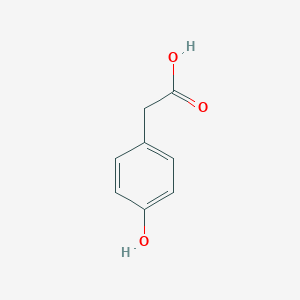|
p-Hydroxyphenylacetic acid, also known as 4-hydroxybenzeneacetate, is classified as a member of the 1-hydroxy-2-unsubstituted benzenoids. 1-Hydroxy-2-unsubstituted benzenoids are phenols that are unsubstituted at the 2-position. p-Hydroxyphenylacetic acid is considered to be slightly soluble (in water) and acidic. p-Hydroxyphenylacetic acid can be synthesized from acetic acid. It is also a parent compound for other transformation products, including but not limited to, methyl 2-(4-hydroxyphenyl)acetate, ixerochinolide, and lactucopicrin 15-oxalate. p-Hydroxyphenylacetic acid can be found in numerous foods such as olives, cocoa beans, oats, and mushrooms. p-Hydroxyphenylacetic acid can be found throughout all human tissues and in all biofluids. Within a cell, p-hydroxyphenylacetic acid is primarily located in the cytoplasm and in the extracellular space. p-Hydroxyphenylacetic acid is also a microbial metabolite produced by Acinetobacter, Clostridium, Klebsiella, Pseudomonas, and Proteus. Higher levels of this metabolite are associated with an overgrowth of small intestinal bacteria from Clostridia species including C. difficile, C. stricklandii, C. lituseburense, C. subterminale, C. putrefaciens, and C. propionicum. p-Hydroxyphenylacetic acid is detected after the consumption of whole grain.
|
 click to show the details of this protein
click to show the details of this protein
 click to show the details of experiment for validating this pair
click to show the details of experiment for validating this pair

